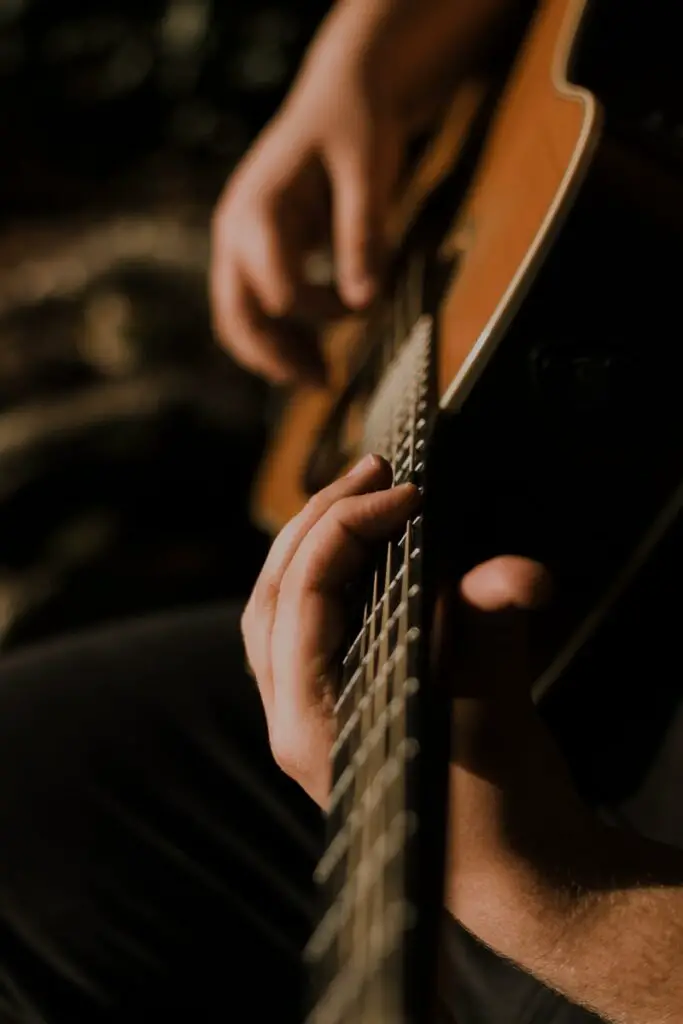
The world is made up of two categories of people – those who love Yahama acoustics and those who have yet to play one. The FG830 is a great example of how far Yamaha has come with their line of acoustic guitars. The fact that you can get such a quality instrument at a great price speaks volumes.
While my primary acoustic guitar these days is a Martin D18, my Yamaha FG830 was my first acoustic guitar and the one that made me fall in love with acoustic music:
That’s one reason I recommend the FG830 in my top 3 guitars for bluegrass music post.
However, I decided it’d be a good idea to provide a more detailed review of the Yamaha FG830, its quality, and why I still feel it is perhaps the best acoustic guitar under $500.
Let’s start off with the design and build quality of the guitar:
Yamaha FG830 Design and build quality
The Yamaha FG830 is an acoustic dreadnought guitar (also called the traditional western body shape). It comes in a solid spruce top with rosewood sides – all designed with an ultra-thin gloss finish.
The Spruce and Rosewood do a great job combining volume and tone on this acoustic guitar. We’ll talk more about the tone later on, but you can hear the FG830’s tone in this video of me playing it:
The scalloped bracing on this guitar is another nice touch. The die-cast chrome combined with this bracing gives you the best of both sturdy and traditional design.
The tortoise pattern pickguard, brown undertone, and the beige/cream binding all come together to make up the beautiful appearance of this guitar:
And the best part: it is sturdily built to last long. I’ve had my FG830 for ten years now and never had maintenance problems. This is despite not humidifying it and generally being pretty lazy in maintaining it. You’ll only need a replacement for this guitar if you choose to upgrade to a more expensive instrument.
The neck
The neck of the FG830 is designed with a satin finish with smooth texture and it allows you to move your hands around the fingerboard with ease. The profile looks smooth and flat.
When it comes to playability, this guitar competes with some of the mid-range acoustic guitars in the US market. When I purchased my own FG830 at Guitar Center, I played several much more expensive instruments before pulling the trigger on this one. The FG830 can go the rounds with much pricier instruments and gives you tons of bang for your buck.
If you don’t believe me, check out this comparison video comparing a Yamaha FG820 to a Martin D28:
The fingerboard has a radius of 400 mm alongside a string capacity of 11m. When you compare it with most dreadnoughts, this guitar is quite standard and comfortable. This noncutaway model means that you cannot go beyond the 14th fret. Of course, the 14th fret will be a lot for many people. However, for those not used to a non-cutaway dreadnought, this limited mobility on the upper frets may be surprising.
In total, the neck has a 20 fret rosewood fingerboard with dot inlays. The neck is a “Nato” neck. Nato necks may not be top grade, but brands like Ibanez and Yamaha have demonstrated that they can still be used in a good quality instrument.
Yamaha FG830 Overall Playability
The Yamaha FG830 comes with top-grade tonewoods. Yamaha’s set up is often top notch right out of the packing/store. There are no rough cuts on the fretwork.
You’ll also find the nut width is narrow, making it stress-free for beginners who mostly struggle with chord fretting. The string action and intonation of this acoustic guitar is a thing to adore:
Overall, the guitar sounds incredible and is highly playable. It grips easily to the hand when seated or standing while offering the comfort level of a typical dreadnought guitar.
However, we usually don’t recommend the Yamaha FG830 for players with small hands (or generally small stature). If that’s your situation, you may actually prefer a travel guitar, or a parlor-shaped acoustic.
Yamaha FG830 Sound and tone
The Yamaha FG830‘s sound is well suited for everything from bluegrass, to country to folk music, as is often the case with dreadnought style acoustic. The output sound is loud enough for everything from couch sessions to campfires.
This dreadnought acoustic guitar is never strident or overly tinny. The mid-range combines lots of heft with palatable highs. This makes the FG830 perfect for strumming rhythms or for cutting through an acoustic band and playing leads.
Yamaha FG830 Overall Value
When it comes to sound, the FG830 is full, impressive and decently balanced. Its overall quality is far above guitars within the same price range, and even competes with much higher priced instruments.
Overall, the Yamaha FG830 offers much higher value than its price would suggest.
Is the Yamaha FG830 Good for Bluegrass?
Yes, the Yamaha FG830 is a great budget acoustic guitar for bluegrass, and I actually consider it a budget version of the Martin D28, which is one of the premier bluegrass guitars on the market.
I talk more about the FG830 and the Martin D28 in my post on the 3 best acoustic guitars for bluegrass.
Bottom Line | Is the Yamaha FG830 a Good Guitar?
Quality-wise, this is a top-of-the-line acoustic guitar that you’ll enjoy playing!
Yamaha is reputable for incredibly valuable guitars at affordable prices and the Yamaha FG830 model doesn’t disappoint.
The only concern I can think of is the available limited color. This guitar is not available in tobacco sunburst or black color (a lot of people go for these colors).
However, the natural color is still beautiful:
Overall, this model is an excellent choice for beginner and intermediate level players and perfectly suited for practicing and jam sessions. That’s why it’s my favorite acoustic guitar for less than $500. For the best pricing, I recommend getting the FG830 on Amazon.

